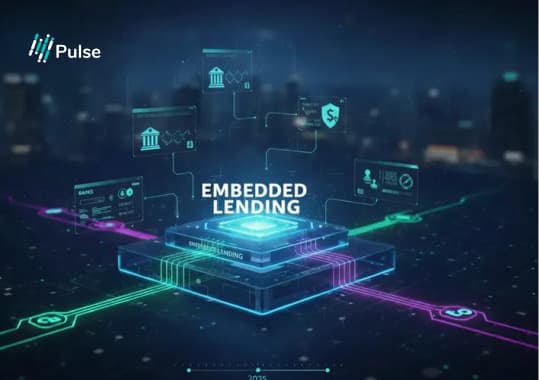We live in the era of instant gratification, where digital experiences are the new norm. Embedded lending is quietly becoming one of the most compelling shifts in financial services. Imagine buying a product, booking a service, or signing up for a subscription, and seamlessly being offered financing precisely when and where you need it, within the same flow, without ever leaving the platform. Seamless credit at the point of need is much more than an added convenience. It’s changing the way people access funding, and it’s defining the future of lending. At the heart of this future lies new infrastructure, which forms the baseline systems that empower embedded lending. Pulse’s Unified Lending Interface (ULI) is well on its way to becoming the baseline infrastructure of embedded lending. It is a suite of solutions built to refine, automate, and streamline the embedded lending journey —from origination and underwriting to loan servicing and automation.
Embedded Lending: Why It’s Gaining Traction
Embedded lending is the practice of integrating credit seamlessly into non-financial journeys. This includes e-commerce, B2B marketplaces, or service platforms. According to a report by Future Market Insights, the embedded lending market is projected to grow at a CAGR of 19.6% between 2024 and 2034, reaching approximately USD 45.7 billion by 2034.
So, what do the numbers mean? We are not looking at a niche or trend any more. Embedded lending is becoming a mainstream channel, and with that comes enormous pressure on the underlying infrastructure that supports it. The traditional loan-origination, underwriting and servicing models simply can’t scale or manage to embed credit into every checkout, app or platform. That means baseline infrastructure needs to evolve, and that’s where Pulse ULI comes in.
How Pulse ULI Is Redefining Embedded Lending Infrastructure
Pulse ULI serves as an interoperable layer and as a foundational tech stack, built specifically to enable embedded lending at scale. Three modular solutions form its core functionality: Pulse LOS (Loan Origination System), Pulse LMS (Loan Management System) and the Einstein aiDeal, Pulse’s signature automated underwriting solution.
- LOS (Loan Origination System): Pulse’s LOS enables digitised KYC and AML and reduces the loan application process to under 3 minutes. It is designed for the embedded context, so a consumer doesn’t navigate elsewhere, fill out huge forms, and wait days for a decision.
- Einstein aiDeal: Being an integral part of the loan origination process, this AI-powered underwriting engine takes underwriting automation and decisioning to a new level. It uses real-time data, AI and alternative sources like Open Banking and Open Accounting to make faster, smarter underwriting decisions, being able to auto-decision 95% of deals in under 45 seconds with customisable criteria. This is critical in embedded lending, where latency must be minimal, and the user experience seamless.
- LMS (Loan Management System): Once the loan is disbursed, Pulse LMS helps automate loan servicing, monitoring repayments, delays and defaults, thus automating collections.
Together, these layers mean that with Pulse ULI, what once may have required weeks of integration, manual underwriting, batch servicing and high friction can now be transformed into a streamlined, near-instant workflow. This technology is a game-changer for embedded lending.
How Banks and Lenders Can Leverage Pulse ULI
For banks and traditional lenders looking to enter or scale embedded lending, Pulse ULI offers a pathway to modernise. Here’s how:
- Automate loan origination and underwriting: Banks and lenders can plug in Pulse’s LOS and Einstein aiDeal to automate loan origination at the point of credit. This means fewer manual steps, faster decisions, and integration with partner ecosystems via easy API integration.
- Digitise servicing and management: By using the LMS module, banks and lenders can move away from batch-based servicing, spreadsheets and legacy systems. Instead, they can migrate to event-driven, real-time servicing aligned with embedded flows.
- Expand distribution via partners: With this infrastructure, banks can seamlessly extend credit, manage portfolio risk dynamically and maintain control of underwriting, pricing, and servicing, all while delivering a seamless embedded user journey.
In short: banks and lenders who adopt the Pulse ULI stack gain both speed, accuracy and the ability to scale volumes and revenue, with no need to invest in infrastructure development. That is a potent mix.
How Brokers and Aggregators Can Use Pulse LOS to Transform the Application Process
For brokers, aggregators, marketplaces and platforms that act as origination channels, the pressure to perform is always high. Users expect minimal friction, and every extra minute in the application is a dropout risk. Pulse’s LOS is ideal for this channel:
- Digitised application process: A broker/aggregator can leverage Pulse LOS to ensure that the application process is fast, digitised and streamlined, completed under 3 minutes.
- Rapid credit decisioning: With Einstein aiDeal, loan decisions can be automated, with customisable criteria and under 45 seconds, raising both completion and conversion rates.
For brokers and aggregators, this means: less drop-off, higher conversions, and an improved user experience. Ultimately, more volume and revenue.
Why Solutions Like Pulse ULI Will Define the Future of Embedded Lending
When you peel back the hype around embedded finance, the real question is: can you embed credit in a scalable, reliable, risk-managed way? A way that hinges on infrastructure, and not just slick APIs, but systems that can handle thousands of applications, underwriting, servicing, risk, compliance, and monitoring? Being able to do so with speed, automation, and elegance. Pulse ULI offers the ideal blueprint for such infrastructure.
As embedded lending grows, finance providers and partners will demand infrastructure that:
- Works at speed and scale
- Integrates seamlessly into third-party platforms
- Automates underwriting and servicing
- Delivers strong risk controls with real-time data and AI
- Provides an excellent experience for end-users (borrowers and merchants)
Pulse ULI ticks those boxes. Its LOS, LMS, and Einstein aiDeal solutions combine to become the baseline infrastructure that embedded lenders will grow to expect. In other words, if embedded lending is going to be the next frontier of finance, the “bridge” and “back-office ecosystem” will be defined by solutions like Pulse ULI. To learn more about Pulse ULI, contact us, today.
Conclusion
As banks, lenders, aggregators, and brokers embed credit into everyday experiences, the ability to offer financing quickly, seamlessly and intelligently will become pivotal. The infrastructure that enables this must be purpose-built for embedded contexts, not retrofitted based on legacy systems. Pulse ULI stands out by providing a complete, easy-to-use tech-stack. It resets the baseline for what embedded lending infrastructure should look like in 2025 and beyond. Automation, digitisation, integration and speed. With Pulse ULI, organisations have the opportunity to not just participate in that future, but help shape it.
Related Blogs


